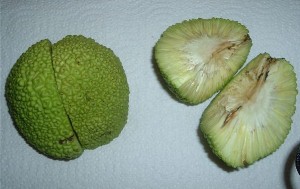





Garden friend D.G. has had much more experience with osage orange than most. His comments on the tree are below:
“I grew up on a small general farm in west-central Illinois, where my father had about a quarter-mile row of osage orange trees, commonly referred to in the area, for obvious reasons, as “hedge trees.” The ones on my father’s farm were planted by my grandfather in the early 1900s, when they served as an impenetrable hedge, particularly around pastures, at least if they were kept pruned to 4-5 feet, I’ve been told. By the 1950s-60s, most had long grown to full size and, as farming had become mechanized and there was longer a need for hedges, most had been removed. Typical trunk diameter of those surviving, as I recall, was about 10 inches.
The fruits are dearly loved not only by squirrels but also by mourning doves, at least during the winter after the fruit has started to deteriorate and disintegrate, which happens especially after it’s gone through some freezing temperature and is probably much easier to tear apart. The trees produce a lot of fruit, which, when green, are hard and filled with a very bitter, slightly sticky, milky sap; tastes really terrible, but I’d just as soon not admit how I know that.
If cows are allowed to eat the fruit in any significant quantity, their milk will be markedly bitter and undrinkable. I don’t know whether there’s any toxicity, but have never witnessed any ill effects on either cattle or hogs.
Fence posts made from mature trees will last at least 30 years, probably more, in clay soil. The only disadvantage is that if the trees are not maintained with some pruning, the natural character of the tree does not incline to straight branching, and as a result, it’s hard to get a high percentage of straight posts. Though not easily, due to the somewhat irregular grain, the posts can be split, using wedges, and the split posts are at least as durable as posts of comparable size made from branches. The wood itself, an attractive mellow red-orange color, is very hard and tough, comparable with yew; the Native Americans knew what they were doing when they used the wood for bows. (As a kid with no money but a good deal of energy and a fair amount of ingenuity, I made a bow from the wood; it worked well.)
True thornless varieties would be a major advantage, as the trees are attractive. In fact, with glossy dark green leaves and intermediate size, it would seem they might be useful and decorative, and at least in the Midwest, are very tough. I’ve never seen one damaged either by disease or insects. However, the references that I looked at grossly understate the quantity, sharpness, and size of thorns, compared with my experience. The thorns on the ones I grew up with ranged from one to one and one-half inches long, without exception, and were needle-sharp. If a dry twig is driven over, the thorns –if they get between the treads– can easily puncture a tire.
For a teen-age farm boy, one way of earning money was to cut “hedge posts,” and I’ve cut at least a few hundred, but I can say with certainty, from experience, that one would not attempt it without wearing leather gloves, and even then, rarely could escape without a few puncture wounds.
All this is, of course, anecdotal, but I can assure you it is accurate!

Osage orange fruit
Copyright © www.100flowers.win Botanic Garden All Rights Reserved